Why Your Dog Can’t Breathe: Brachycephalic Obstructive Airway Syndrome
It’s not uncommon for owners of brachycephalic dog breeds such as French and English Bulldogs, Pugs, Pekingese, and Shih Tzus to be concerned that their dog can’t breathe.
These breeds have a shortened skull with very little normal nose that predisposes them to issues such as heat stress, snoring and snorting and exercise intolerance known as brachycephalic obstructive airway syndrome (BOAS).
Sadly, many of these dogs suffer from major airway disease, a problem that has far-reaching consequences, including death.
In this article, we explain what dogs are most at risk, what signs you need to look out for and what you can do as a pet parent to keep your dog safe.
An Example Of A Dog With Abnormal Breathing
In this video we see a severe example of a Pug struggling to breathe.
This is because of narrow nostrils and an elongated soft palate.
It is likely this poor pup is also suffering from everted saccules and maybe laryngeal collapse and/or tracheal collapse. I will discuss more below.
What Are Brachycephalic Dogs?
In simple terms, many people will often refer to brachycephalic dogs as those that have a squished up face or “squishy nose breeds”.
Brachycephalic means ‘short-headed’ and the common breeds that have this type of anatomy include Pug, Pekinese, French bulldog, Boxer, Mastiff, Boston terrier, English bulldog.
These dogs have been bred to have a very short nose/muzzle so that they have a flat face.
Yes, humans bred these dogs to have a problem!
Why Are They Affected By Obstructive Airway Disease?
The consequence of being a brachycephalic breed is that many have internal anatomical conformation that makes breathing very difficult.
This includes:
- Stenotic Nares
- Pinched Nose
- Elongated Soft Palate
- Everted Laryngeal Saccules
- Laryngeal Collapse
- Tracheal Hypoplasia
Most vets would say that all brachycephalic dogs suffer from at least one of these airway abnormalities, the vast majority suffering from stenotic nares or an elongated soft palate.
Breed societies are treading a fine line and efforts do need to be made to improve the breed standard so that these dogs don’t need surgery just to survive.
Dogs that require surgery to correct airway obstruction should not be used for breeding.
Brachycephalic Airway Anatomy
Stenotic Nares
Stenotic nares are malformed nostrils that either don’t allow air into the nasal passage because they occlude the entry point, or because they collapse in during breathing.
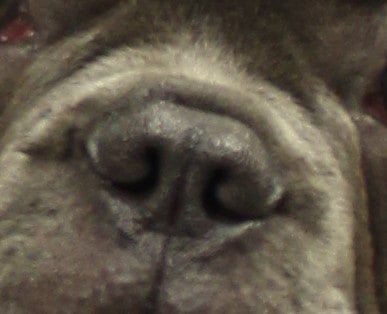 Mildly stenotic nares/nostrils.
Mildly stenotic nares/nostrils.
 Severely stenotic nares/nostrils.
Severely stenotic nares/nostrils.
 Dog with normal shape nostrils allowing plenty of air into the nasal system.
Dog with normal shape nostrils allowing plenty of air into the nasal system.
Elongated Soft Palate
The soft palate is the soft part of the roof of the mouth as opposed to the hard part.
An elongated soft palate is one that is longer than usual and extends into the larynx often entering or occluding the opening of the trachea (wind-pipe).
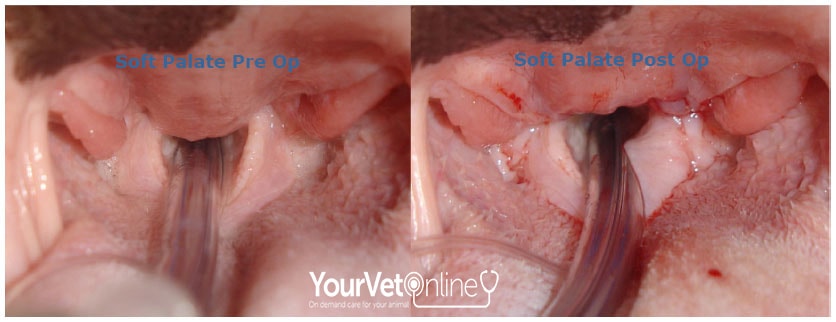
This picture shows an elongated soft palate pre-surgery that sits on the ET tube. After surgery, it has been trimmed so that the airway is open and not obscured. Photo courtesy of Cambridge University Vet Department.
Everted Laryngeal Saccules
Laryngeal saccules or laryngeal ventricles are small soft tissue masses located between the vocal folds and the lateral wall of the larynx.
In brachycephalic breeds, the saccules can become everted and protrude into the laryngeal opening, when the air pressure in the larynx is high.
This can cause brachycephalic airway symptoms such as snoring, noisy breathing, coughing, nasal congestion, and shortness of breath in affected dogs.
Laryngeal Collapse
Laryngeal collapse occurs when the structures of the larynx become weaker and the cartilage loses structural integrity due to the increased pressure of trying to breathe.
It is sometimes referred to as aryepiglottic collapse or corniculate collapse.
Dogs who have laryngeal collapse struggle to breathe in (they suffer from inspiratory distress).
Whilst laryngeal collapse can occur at any age, it tends to get worse with age and if steps aren’t taken to improve airway dynamics i.e. Boas Surgery.
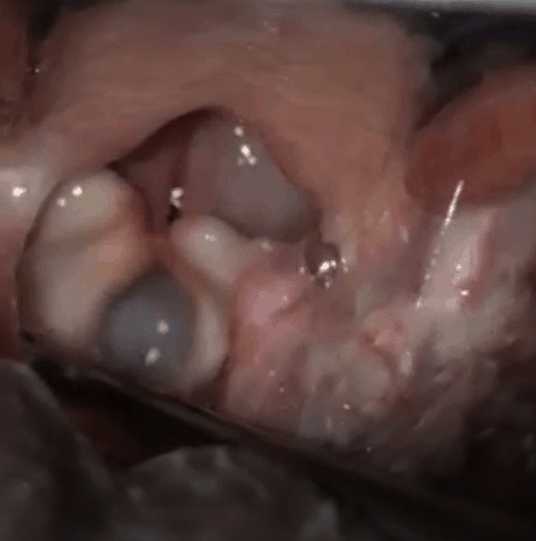
The larynx has collapsed in this view. There is very little movement. Large everted saccules (shiny grey/pink) are also occluding the airway. This dog would struggle to breathe at all times and this is a welfare concern.
Hypoplastic Trachea
Many dogs with brachycephalic syndrome also suffer from a hypoplastic trachea, which worsens the prognosis.
A hypoplastic trachea is a trachea that has a much narrower diameter than normal.
A narrow diameter increases air resistance placing more strain on the lungs.
English Bulldogs have the highest incidence of hypoplastic trachea within brachycephalic breeds (55%).
What Can Vets Do To Help My Dog That Can’t Breathe?
If your dog makes a noise when it is breathing that means that there is a problem.
A normal dog makes NO noise.
To diagnose what the problem is your vet will take a full history.
Your dog will need a general anaesthetic to assess the larynx to determine what problems are present and what surgery might be required.
Your dog may also require an xray to determine if there is a hypoplastic trachea or if there are signs of pneumonia (a common problem).
This video shows you what we look for and what we see during an exam of the upper airway for a dog with obstructive airway disease.
What Are The Risks Of Brachycephalic Obstructive Airway Surgery (BOAS Surgery)
No surgery is without risk and this is one surgery where post-op complications can be very serious.
It’s very important that you discuss this surgery and the potential for complications with the veterinary surgeon that will be performing the surgery on your dog.
Risks are very specific to the individual dog and no two dogs are the same.
The main complication with BOAS surgery is the development of severe swelling of the laryngeal tissues post-surgery.
This is controlled by using medications and ice, however, some dogs will appear fine after surgery, only to deteriorate 6-12 plus hours later.
The vast majority of dogs that do suffer from complications are those that are older than 2 years, are overweight and have a serious obstructive disease.
For this reason, many vets will recommend these dogs have surgery performed at a specialist centre with 24/7 overnight emergency care.
When a post-op complication makes it difficult for the dog to breathe, a tracheostomy may be required.

In severe cases of brachycephalic airway disease where the dog can’t breathe, a tracheostomy may be required.
Many vets choose to perform BOAS surgery in young dogs, often at de-sexing time around the age of 6-10months.
Surgery at this young age can decrease the risk of complications mainly due to:
- the dog is not usually overweight and
- there are no secondary problems due to not enough time passing with the increase in pressure that contributes to laryngeal collapse, everted saccules occluding the airways.
However, as always this is a generalisation and a vet is the best person to talk to regarding when to perform this surgery.
Most vets will recommend that stenoic nare surgery (either punch resection, alar wing amputation, laser ablation, vertical wedge, horizontal wedge or alapexy) is performed at desexing.
However, it is recommended that the dog is allowed to reach anatomical maturity before soft palate resection surgery is performed.
Of course, if the young pup is struggling to breathe and there are indications for surgery then of course, by all means, you must do it.
As with all surgeries and BOAS surgery is no different, there are risks associated with anaesthesia, bleeding, infection and wound breakdown.
What If I Don’t Choose To Have BOAS Surgery On My Dog
The majority of brachycephalic dogs suffer from some form of obstructive airway disease.
It becomes a very big welfare problem if you don’t have this surgery performed.
These dogs are suffering.
We often hear of cases, and I certainly see cases as a vet where an owner has come home to find their dog dead.
Remember dogs PANT to cool down, if they can’t breathe properly they overheat.
The earlier you can perform surgery on these dogs, the better their quality of life.
This is a progressive syndrome.
First the stenotic nares and elongated soft palate are the primary components, however as time goes by the high pressures associated with trying to breathe through a small gap result in everted laryngeal saccules and laryngeal collapse.
The altered mechanics of breathing then affects the lungs.
Changes in intrathoracic pressure can result in pulmonary oedema.
High air resistance due to stenotic nares can lead to poor lung ventilation.
This in turn results in pulmonary hypertension and right-sided heart enlargement and ultimate heart failure and death.
Sadly, this is not uncommon.
Often BOAS is also associated with vomiting and regurgitation.
Many animals struggle to eat properly, gulping down their food without chewing, because they can’t breathe through their nose.
Recommendations If Your Dog Can’t Breathe Or Makes Abnormal Breathing Sounds
- Book an appointment with your vet to assess your dog for brachycephalic obstructive airway syndrome. Our vets are also able to give you broad advice.
- Have surgery performed on your dog sooner rather than later.
- Take care to always provide a cool area with plenty of shade and access to water.
- Make sure you don’t over-exert your dog during exercise. If they look stressed, stop and slow down.
- If you notice your dog has a blue tinge to its tongue, is panting heavily or has changed to a bright red colour with collapse, get to your nearest vet immediately.
Do you own a dog that has brachycephalic obstructive airway syndrome? Tell us about what you have done to cope, did you do surgery?
Listen to Dr Leigh discuss Brachycephalic obstructive airway syndrome in this video:
- 51
- 51

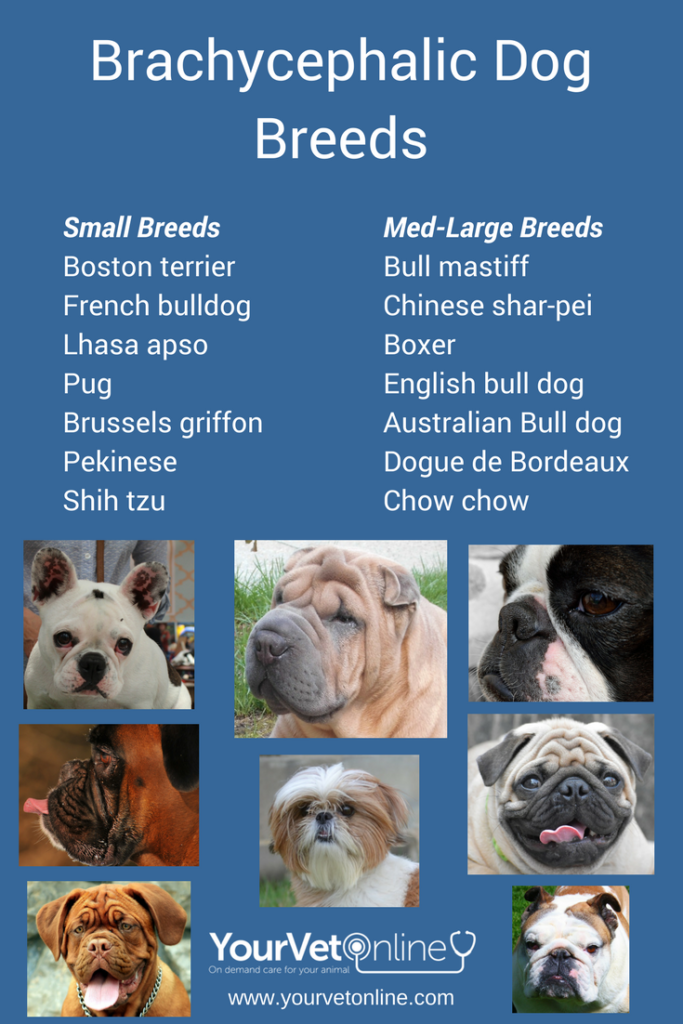
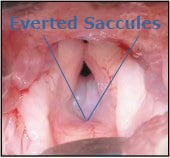

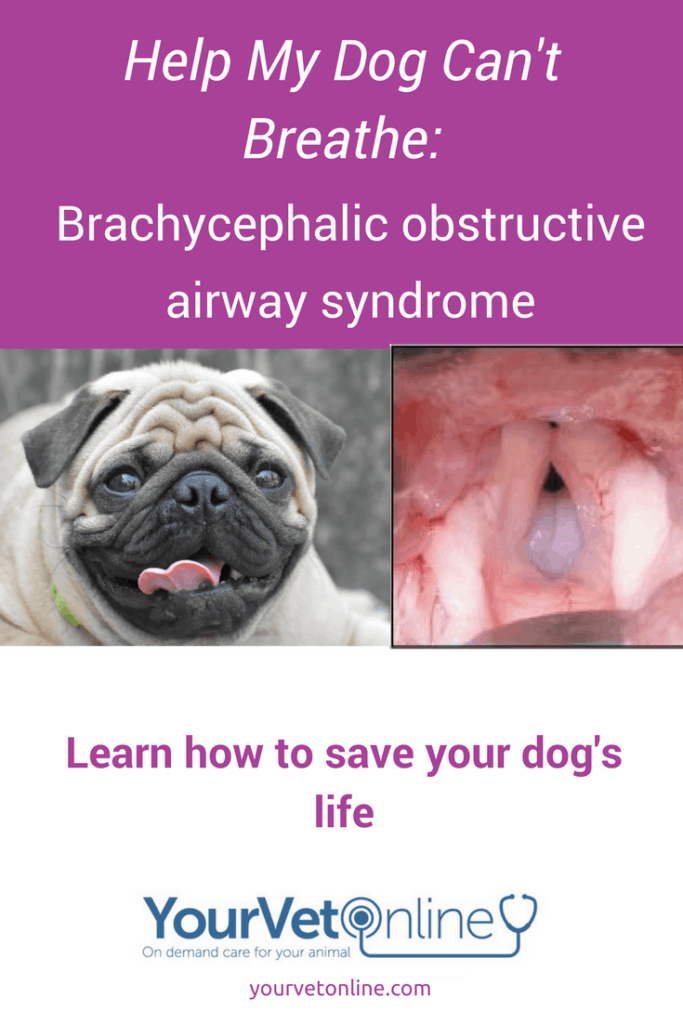
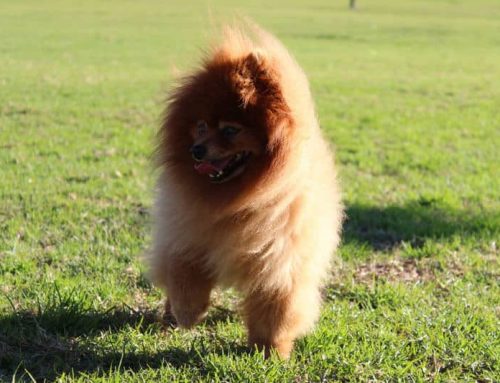
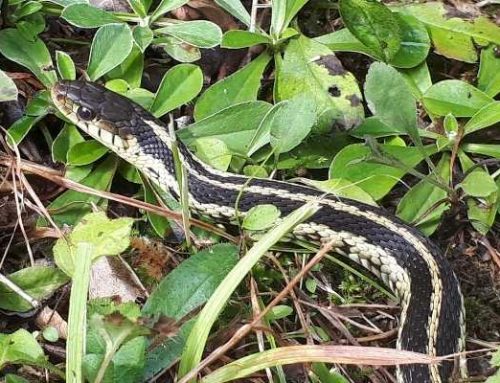
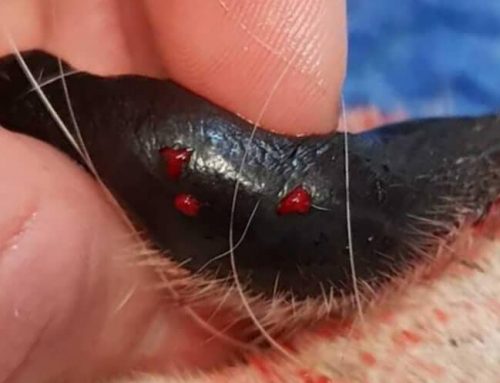
This is happening to my British Bulldog also she has had the nasal snare operation 3 months ago.
But her breathing seems to be stressed through her nose still?
I’m so worried about her not getting enough air through and she moves into several different positions all night long to try and get more air.
I’m worried sick?
My vets don’t seem to be able to offer any help.
Hello! My frenchie had surgery for her nares and elongated palette and now she suffers from sleep apnea. She sounds congested. Our vet described it as sucking a thick milkshake through a straw that collapses. Of the 3 vets that I have contacted about this, they all say that due to her small airway that they cannot do anything to help. I have video of how she sleeps if I could share . I feel like i should not have gotten the surgery. Watching her uncomfortably sleep is painful. I’m afraid she is going to stop breathing. Please help!